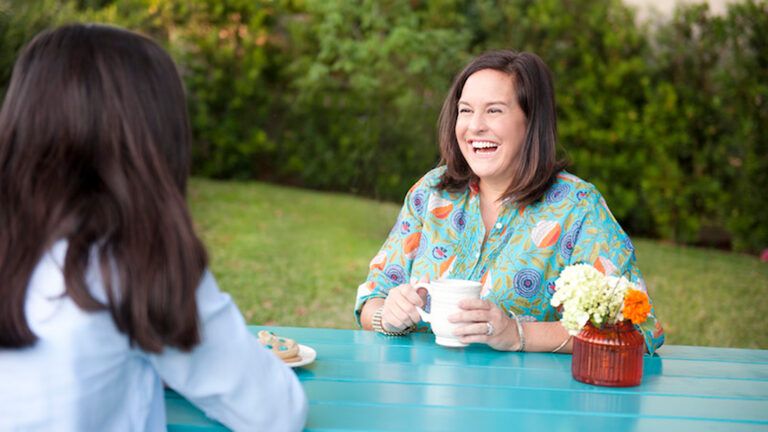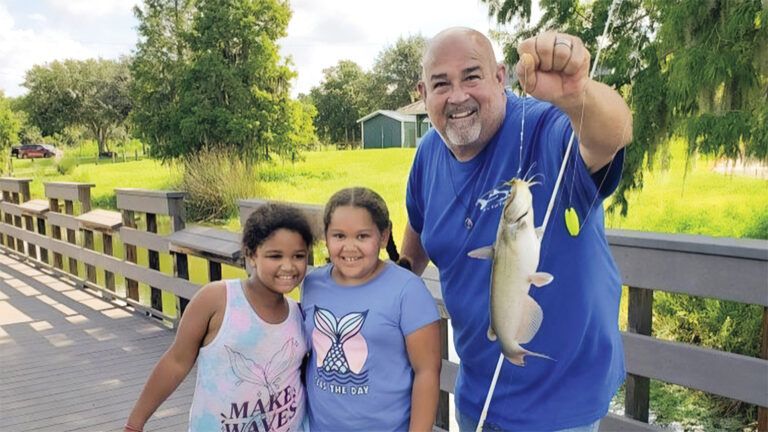The bright orange tarp is spread out on the hard-packed desert sand and filled with strawberries, cherries, cupcakes, Twinkies, hot sauce, Pop-Tarts, Milky Ways and our homemade PB&J burritos. We have gallons of ice-cold lemonade and iced tea ready to pour and lots of vitamin I: ibuprofen for those aches and pains that come with serious hiking. We’re on the Pacific Crest Trail, a hundred miles north of the Mexican border. Day Six for most thru-hikers.
They start coming at 9:30 in the morning, boots kicking up dust. I don my angel wings—a big feathery appendage from the Dollar Store—to greet them. Our sign says Majik, the words spelled out in pink duct tape. Trail magic is what hikers call it, the unexpected blessings that appear on their journey. Doing this year after year has proved a blessing on my own life journey. But it wouldn’t have come about without prayer.
I was a police officer in the coastal town of Oceanside and, before that, a Marine. When I retired, I stayed busy volunteering. I taught wilderness skills to kids, and in another program we paired at-risk youth with first responders to do a ropes course, teaching them teamwork and leadership. I served on the Eagle Scout review board. I liked being outdoors and getting exercise. “You seem pretty happy being retired,” my wife, Emmy, observed. I was.
Then in 2007 our good friends Marty and Norma decided to thru-hike the Pacific Crest Trail, starting down at the Mexican border and going all the way north to Canada. Five months of the great outdoors, five months of facing the elements. I’ve done my share of backpacking, going to the top of Mount Whitney and the bottom of the Grand Canyon, but hiking one end of the PCT to the other—a trek of some 2,600 miles—was out of my league. They invited us to see them off at the southern terminus. We couldn’t pass up the chance. “It’s amazing all the work and planning they’re putting into this,” I told Emmy.
There’s a mighty short window of opportunity for thru-hikers. Some years, they can’t start earlier than late April because of snow in the Sierras and can’t go later than mid-May because of snow in the Cascades. The last weekend of April, we joined Marty and Norma at the start of the trail, before they headed off toward the Anza-Borrego desert. It was almost like a party: booths set up, vendors selling gear, friends and family cheering on loved ones.
Emmy, Marty, Norma and I gathered at the southern terminus early in the morning. We held hands and prayed. We waved goodbye as, laden with backpacks, our friends stepped out on a narrow sagebrush-lined path. “I’ll be praying for you,” I promised.
And I did. I could imagine what it would be like, the stunning views, the starlit skies, the wildlife, the flowers. But also the fatigue, the burnout, the aches and the blisters, the blazing sun, the bitter winds.
I looked at a map and figured out where they’d be after one hundred miles, a spot called Eagle Rock because of a magnificent raptor-like rock formation. It would be easy enough for me to meet them there. I could drive to Warner Springs and then hike in four miles with some food and drink. A welcome surprise, I hoped.
I went to McD’s, bought some burgers and fries and drinks for them—and for whoever else might show up. I put the food in a backpack, and then we hiked toward Eagle Rock. We met Marty and Norma before we reached it, midmorning. Together we sat under a scraggly elderberry tree. They seemed really glad to see us. So did the other hikers. We chatted, and they ate voraciously. One lady who claimed to be a vegetarian didn’t seem to mind getting a burger. She dubbed me “Hamburger Helper,” and the name stuck. (Okay, I also ended up making a laminated label for myself from a Hamburger Helper box.) “You’re a trail angel,” someone else said. Hence the wings from the Dollar Store.
It was great to see Marty and Norma. But even more fun to see how many others could use my help. I have been doing it ever since.
I’ve seen how popular some things are, like Tabasco sauce packets (“I’ve been dreaming about this stuff all week,” said one guy) or frozen mini Snickers bars carried in an insulated pouch (“You’ve done this before,” said someone else). Some hikers are woefully unprepared, glad for bandages or new laces. We came across one lady sitting by the trail with her socks and boots off, crying, rubbing the blisters on her feet.
“This shouldn’t be happening,” she said. “I’m a veteran hiker.” We offered bandages as well as emotional first aid.
For that inaugural weekend in April, I take along some buddies. We bring in enough trail magic to feed 35 to 40 hikers. We have our own trail names, such as Sundance, Raven and FireKapten (a fire chief before he retired). And we’ve met up with some similarly named hikers like Sweet Tooth, Dance Party and Guy-on-a-Buffalo. Perhaps my favorite was Free Refill, who appropriately enough praised us for our drinks.
I like pointing out the grinding hole in the rock on the edge of the trail, where Native Americans turned acorns into flour. And I once had to explain to a hiker that the “white golf ball” he saw on top of a hill was actually the observatory on the top of Mount Palomar. But some questions are easier to answer than others.
“How much farther to Eagle Rock?” one fellow asked plaintively. He practically levitated when I told him it was right behind him. Ain’t that often the case? We don’t always know how close we are to our journey’s goals.
As you might expect from a former policeman and Marine, I have a few rules. We begin hiking back by 3 p.m., and we leave no trace behind. Everyone is asked to sign the log I bring, and no cash donations are accepted. The notes in the log give me much pleasure at home: “Thanks for the confidence booster,” “You have restored my faith in humanity,” “Thank you for welcoming us as Christ would….”
Funny about that last one. That is exactly as I like to see it, even if I don’t always say those words. I remember once getting an e-mail about a hiker who desperately needed new insoles. I made a special trip to the store and bought them for him, ready to receive what I figured should be overwhelming gratitude. All he said was “How much do I owe you?”
I was a bit put out. But then I reminded myself, Who am I doing this for? For me or for them? I should be thanking hikers for the opportunity to help.
That, I’ve discovered, is the key to retirement. Doing for others. I do other volunteer work closer to home, like maintaining the Coast to Crest Trail for San Dieguito River Park. And I’ve been known to bring trail magic to other hikers—don’t ask me about the time a bunch of cattle mistook me for one of their own because of what was in my backpack. But I’m especially committed to those thru-hikers at Eagle Rock.
They helped a Hamburger Helper discover his angel wings.
For more inspiring stories, subscribe to Guideposts magazine.





